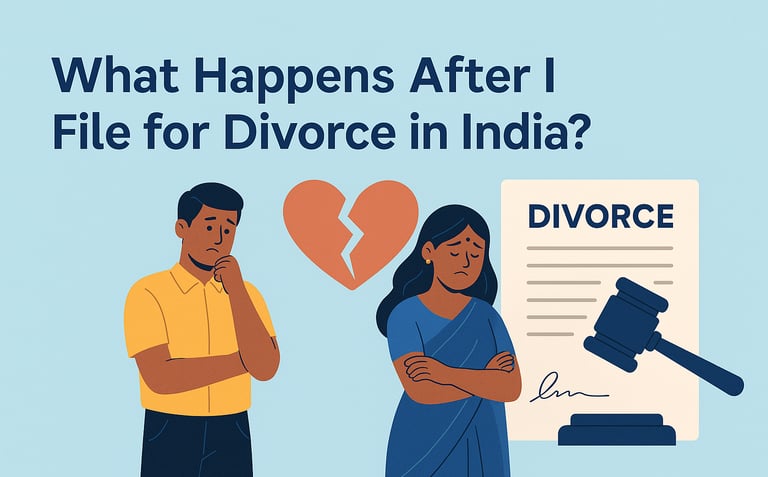What happens after I file for a Divorce in India
Divorce in India involves notices, reconciliation, evidence, court rulings, and decisions on custody, alimony, appeals, and interim reliefs.
FAMILY LAW
Shrish Khirwal
7/11/20254 min read


Filing for divorce is an emotionally stressful decision, bringing one's life to a close chapter. The legal process only begins after the filing of the petition, though. In India, this can be quite different depending on whether the divorce is mutual or contested. It is important for a person experiencing this painful episode to know what steps lie ahead. This article will clarify the processes that take place once the divorce petition is filed in the jurisdiction of the Indian courts.
Initial Steps: Notice and Appearance
After a divorce petition is filed in the appropriate family court, the first significant step is a summons or notice being served on the respondent (the other spouse). The notice properly gives the respondent notice of the petition and orders them to be in court on a particular date. The first appearance is very important because it is the formal beginning of the legal process for the respondent.
Reconciliation and Mediation
Indian law, specifically the Family Courts Act, 1984, lays great stress on reconciliation. The court usually refers the parties to mediation or counselling prior to initiating the divorce process. This move gives the couple a chance to find out if they can make up and withdraw the divorce petition. In divorces due to mutual consent, this period is often spent ensuring that both parties really are comfortable agreeing to the separation and hammering out the final details of their agreement concerning alimony, child custody issues, and property division. In contested situations, this is a forced attempt to save the marriage and almost never works if the parties are set in their positions.
Filing of Written Statement/Reply
If negotiations are unsuccessful, the respondent must file a 'Written Statement' or 'Reply' to the divorce petition. This is their formal response to the allegations and claims made by the petitioner; as such, it provides the respondent with the opportunity to state their own version of events, accept or reject the facts, and bring any counterclaims if applicable. The petitioner may then file a 'rejoinder' to the written statement, again giving expression to their stand. This filing of pleadings assists the court in determining the main issues in contention.
Interim Orders and Applications
While waiting for a decision about the divorce lawsuit, each party can make applications for interim orders. These interim orders are short-term court orders intended to settle urgent issues until a final ruling is made. Common interim applications are:
Maintenance Pendente Lite (Interim Alimony): One party, usually the wife, may apply for financial maintenance from the other party during the court proceeding for day-to-day living expenses.
Interim Child Custody and Visitation: Requests can be made for temporary child custody and visiting rights so that the child remains safe and maintains a continued relationship with both parents.
Injunctions: Injunctions in the form of orders to restrain a spouse from alienating property or harassing the other spouse.
These interim directions are imperative in granting speedy relief and stability to the parties, particularly children, during the course of the main divorce case.
Evidence and Cross-Examination
This is usually the most time-consuming part of a contested divorce. Both parties are provided the opportunity to submit their evidence in favour of their claims. These include:
Oral Evidence: Witnesses are examined under oath.
Documentary Evidence: The documents related to the marriage certificate, money records, correspondence records, and property records are produced.
Each witness produced by one side can be cross-examined by the lawyer of the opposing side. Such an intense procedure aids the court in establishing the truth and authenticity of the evidence.
Final Arguments
After the presentation of all the evidence and cross-examinations, both sides' lawyers make their ‘final arguments’. At this stage, the lawyers recap their case, raise high points of evidence, and argue how the law fits the established facts. They seek to convince the judge of their client's case and why the divorce should be awarded or refused and on what basis.
Judgment and Decree
Following the last addresses, the court pronounces its judgment, and on the date of pronouncement, the judge hands over the 'Judgment' or ‘Order,’ which sets out the court's conclusions on the facts and the law. If the divorce is awarded, a formal 'Decree of Divorce' is issued. The decree is legally dissolving the marriage and will also include specific orders as to:
Permanent Alimony/Maintenance: Whether one spouse will provide regular financial support to the other.
Child Custody: Who will have custody and the visitation arrangement for the non-custodial parent?
Property Division: How assets and liabilities of marriage will be split.
Costs: Who will pay the legal fees?
Appeal
Either spouse, if they are not content with the verdict, can appeal in a higher court (e.g., the High Court) within a specified time frame, normally 30 to 90 days, depending on the law under which the divorce was sought. The higher court examines the ruling of the lower court, and its verdict can affirm, alter, or revoke the original decree.
In conclusion, Indian divorce, however, is more than just a starting point in the long and arduous legal process. From the first notice and compulsory reconciliation attempts to the elaborate laying out of evidence, final submissions, and the eventual verdict, every step needs to be carefully navigated with the skills of the law. Though the process can be emotionally and financially exhausting, familiarizing oneself with these procedural steps can prepare one for what is in store and enable individuals to make informed decisions along the way through the painful process of marital termination.
